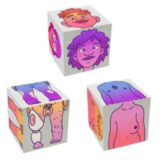Now take a look at the genitals, legs, hair and the feet in the pictures. Genitals are just another part of the body that comes in different shapes and sizes. However, a lot of people don’t like to talk about them in public. At the same time, they are an important part of how people think about each other. Some people believe that are only two kinds of genitals, and that each kind does or should always go with certain other body traits or looks, like hormones, chromosomes, breasts hair and clothing. Others might think that genitals decide – at least a little – who you are and how you feel (a boy or a girl; this is also called “gender”), what you should do (the toys people expect you to play with or how to play with others) and who you might want to have as a partner. Often adults even choose a baby’s name so the others can guess its genitals and therefore all these things too.
Many people believe there are only boys with penises (cis boys) and girls with vulvas (cis girls), but that isn’t true. Genitals look different from person to person. Some babies are born with genitals that don’t fit the usual ideas of a boy or girl, because their genitals are a mix between penis and vulva. These babies are called intersex. Sometimes doctors change their bodies with surgery to make them fit what people expect, but that can hurt them and make them feel bad. Some girls have penises (trans girl), and some boys have a vulva (trans boy). Some children feel like a boy and a girl in the same person, and some feel like none of both (they are usually called non-binary, but there are many more genders).
Belonging to a group, for example the group of boys or girls, can make children feel special and happy. However, it can also feel painful when you don’t fit in – maybe because you don’t feel like a boy or a girl, because you want to play in your own way, or because you like someone whose genitals people don’t expect. Children and adults usually feel happiest when the people around them let them be themselves and love them for who they really are.
Most people have two legs, some people don’t. In the images, for example, one person has an artificial leg. You may not often see people with only one leg within your friends and families, at school or in the movies. In the world, some people walk, some roll; some talk with their mouths, some use signs with their hands. You can all do amazing things with your bodies – you might just do them differently. What is important is that you can all have a good time together.
Having a good time together is difficult when people who walk on two legs and speak with their mouths have certain ideas about those who cannot do that. They might think that people with only one leg have a problem. (Maybe they think they are sick, they feel sorry for them or they admire them too much). But people don’t have a problem because they only have one leg; they have a problem because people with two legs try to tell them what to do and where they can or cannot go. Instead of guessing what someone needs, you can ask and get to know each other. If you feel like it, you can ask: “Would you like to play with me?” And if you are not yet sure about how that works with your different bodies: “How can we play together?” If you don’t yet know someone with only one leg in person, you can find them talk about their experiences and wishes for the future online.
Some people have two feet, some people have one and some people have none at all. In the images, most people have two feet, while one person uses an artificial leg and foot to walk. Often, feet are hidden inside shoes, so we rarely see them. Feet can be big or small, flat or crooked. Some people’s toes are close together and others’ are spread apart. Just like faces or hands, all feet can look different. Although some people even have ideas about what beautiful feet should look like, we don’t need to look the same. Every foot and every way of moving makes us unique and every body is wonderful just the way it is.
